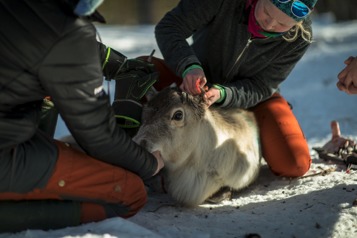- About
- Topics
- Picks
- Audio
- Story
- In-Depth
- Opinion
- News
- Donate
-
Signup for our newsletterOur Editors' Best Picks.Send
Read, Debate: Engage.

“The climate change has definitely affected the Sámi people. I think that all the indigenous cultures are probably the first ones to actually notice it, because we live so close to the nature.”
– Maxida Märak interview with the Environmental Justice Foundation, 2018
The climate crisis is an injustice, with the damaging effects of the richest countries’ carbon emissions being borne by those who are least responsible. As it renders places and seasons unfamiliar, it is often those with the closest ties to land who are threatened the most.
Indigenous peoples the world over feel the effects of climate change acutely, as their livelihoods often depend on natural resources. The violence of climate change is inflicted on their rights, including the rights to self-determination and to traditional lands, territories and resources.

In the Sápmi, a 150,000-square-mile area covering the northernmost reaches of Norway, Sweden, Finland and Russia, the Sámi have lived with reindeer since time immemorial. The changes they have observed over the past thirty years are chaotic and dislocating. Warmer winter temperatures are making old migration routes across lakes and rivers impassable for fear of too-thin ice. At the grazing grounds, increased rainfall has frozen to form a thick barrier of ice, barring the reindeer from the nutritious lichen underneath. In 2013 alone, 61,000 reindeer died as a result of these conditions in Arctic Russia.
Rising reindeer deaths are felt at an economic, cultural, and even existential level to the Sámi, since belonging to a herding community is the basis of their indigenous rights. The Swedish Sámi have been the victims of colonial era assimilation in the past – forbidden from speaking their own language in schools – as well as segregation, and were kept on the fringes with their traditional ways of living. Now, the climate crisis is placing them in a double bind, as their landscape becomes unworkable and unliveable. But other kinds of change are coming.
Maxida Märak, 30, is part of a new generation of native artists and activists, using their media platforms to tell the world about the climate and political problems which beset their communities. Her view of the world is, perhaps especially, multifaceted: with sell-out tours and an Instagram following of 34k, she recalls growing up in a culture where five to six weeks were spent up in the mountains, devoid of bathrooms and electricity, let alone 3G.
The changes brought along with time and education have opened new doors to Maxida’s generation, who are in positions of power as lawyers, journalists, scientists, and artists. Now, she says, only 10% of the Sámi population work in reindeer herding. Yet clearly the herder’s existence and relationship to the land is fundamentally precious to the Sámi’s continuation as a distinct people, and any threat to it is of major concern.
Keeping old paths open has a special resonance for indigenous communities, whose connection to the land is a source of resilience and memory, survival and culture. As a National Geographic article notes, the Sámi language itself reflects a powerful bond between herding and vital traditions: ‘the word for "herd" is eallu; the word for "life" is eallin.’ There are 400 different words for snow, which no longer correspond with the unseasonable realities. Climate change is a battle to halt erasure across all these cultural lines.
For the Sami, the life-altering effects of global warming are compounded by local fossil-fuel-burning industries. They face encroachments onto their land from mining, oil, gas, and forestry companies, inhibiting their ability to adapt and explore better summer grazing areas. And then there’s the industrial waste, dumped into pristine fjords or belched into the air; cryoconite, a toxic black dust, restricts lichen growth when it falls on snow.
The degradation of the Sápmi by rampant polluters is particularly unjust when you consider that the people’s aim is not, nor has it ever been, to seek profit, but simply survive. As Maxida says, “[Our] goal is never money. The goal is to make it all go around. And when you start to notice that it doesn’t go around, something is definitely wrong. And we are noticing that now.”

Maxida’s interview with EJF sends a message of strength – testifying to indigenous communities’ resourcefulness – and hope, which she sees represented by the ascension of her generation to positions of power and thus decision-making. The perspective of native peoples in policy-making rooms is paramount: they know the places of which conservation programmes speak, and the full meaning of words not yet obsolete. Feminist, artist and environmentalist, Maxida’s words are above all a call to action:
There are only a few places, in the world, where the ground and the land and the water are left like it is today. And we have that. And I cannot understand that people don’t put value into that. That, for me, is just… it’s crazy! And in 30 years, people will stand and say […] What did you do? You could have saved it! And you didn’t!”. My daughter’s generation, they will stand there and say: “why didn’t you save it?”.
Read more stories of how climate change is impacting the Sámi in EJF’s briefing: Rights at risk: Arctic climate change and the threat to Sami culture.